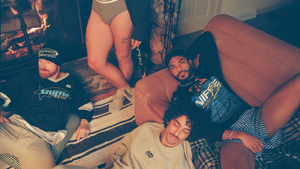CONTACTAbout UsCAREER OPPORTUNITIESADVERTISE WITH USPRIVACY POLICYPRIVACY PREFERENCESTERMS OF USELEGAL NOTICE
© 2025 Equal Entertainment LLC.
All Rights reserved
All Rights reserved
By continuing to use our site, you agree to our Privacy Policy and Terms of Use.
We need your help
Your support makes The Advocate's original LGBTQ+ reporting possible. Become a member today to help us continue this work.
Your support makes The Advocate's original LGBTQ+ reporting possible. Become a member today to help us continue this work.
Brilliant and beautiful, Mitrice Richardson found it easy to make people fall in love with her. The 24-year-old's charm was evident the evening of September 16 when she showed up at a glamorous Malibu, Calif., restaurant to eat dinner by herself. A group of young people soon asked her to join their table, and they enjoyed her company even though they found her banter increasingly odd.
Richardson told her dinner guests she was from Mars and reportedly began speaking in gibberish. This was not typical behavior for the former beauty pageant contestant, who graduated from Cal State Fullerton with a 4.0 grade point average, held down two jobs, volunteered for charity, and was in a committed relationship with another dynamic young woman.
Things went from weird to uncomfortable when Richardson couldn't pay her $89 tab for Kobe steak and an ocean breeze cocktail. After she unsuccessfully tried to have her grandmother pay the bill over the phone, the restaurant called Los Angeles County sheriff's officers. The cops found a small amount of marijuana in Richardson's 1990 Honda Civic. Richardson's car was impounded, and she was taken into custody at a Malibu sheriff's station on suspicion of defrauding an innkeeper and possession of marijuana.
Shortly after 1 a.m., Richardson -- who lived more than 30 miles away, in south Los Angeles -- was released on her own recognizance from the isolated station. An employee told Richardson she could spend the night at the station, but she declined the offer. She allegedly left without money or identification, which her family says remained in her impounded Civic. City buses had stopped running hours earlier.
Mitrice Richardson has been missing ever since.
This missing woman case didn't gain much traction in the media during the
first few weeks after her disappearance. She's young and pretty, but she's
also black, a lesbian, and works part-time as a dancer at a gay
nightclub. Nancy Grace et al typically glom onto kidnapping victims
of a certain demographic -- young, straight, privileged white women.
Flipping that script, Richardson's brilliant smile graced the cover of People on Thursday, along with five other young Americans who
disappeared without a trace (though the two-paragraph People piece had
no mention of Richardson being gay or dancing at a lesbian club).
Unlike
many missing people, Richardson did leave clues in her wake. She was
briefly spotted in the backyard of a Malibu home around 6:30 a.m. on
September 17. It's believed Richardson walked for hours after her
release from the Malibu station. The Los Angeles Police Department took
over the case from the Sheriff's Department, and days after Richardson was reported missing, they searched the
area's hills and canyons to no avail. But they admit there are now fresh
leads.
"Just this week -- it's a little bit out of the area but not too far from Los Angeles -- there was a possible sighting in Thousand Oaks," LAPD detective Chuck Knolls says. "There was someone who saw a young black woman in a rural part of Thousand Oaks and called it into the Ventura County sheriff. They responded with park rangers and didn't find anybody."
The Thousand Oaks spotting gives Knolls and Richardson's family hope the young woman vanished of her own accord. But it's not clear why she'd want to abandon her family or friends, and there's little evidence -- other than her strange behavior in Malibu -- that she was struggling with a mental illness that may have left her confused or irrational.
"She wasn't diagnosed with any [mental illnesses]," says Tessa Moon, Richardson's girlfriend of two years. "She wasn't getting any medication."
Moon moved to the Bay Area for work six months after she met Richardson, and they've been in a long-distance relationship ever since, seeing each other two to three times a month. Moon was in Northern California the night Richardson disappeared, and since September 17 she's shuttled between her home and Los Angeles to speak to the LAPD and anyone who might know anything.
"There's only so much I can do [in the Bay Area]," Moon says. "I'm constantly making trips back and forth, which I have no problem doing -- anything to find her -- but it's really getting frustrating and hectic."
Equally weary are Richardson's parents. "Being skinned alive" is how Latice Sutton, Richardson's mother, described the experience of Mitrice's disappearance to People. Richardson's parents are divorced, but both are a presence in their daughter's life. Michael Richardson, an employee of the Saban Free Clinic in Los Angeles, has been outspoken about the LAPD's handling of the case ("they're not doing anything") and, up until the People cover, the paucity of media coverage. There's one group though, that he can't commend enough.
"I'm highly grateful to the gay and lesbian community," Richardson says. "They've been working with me, calling me, coming up with ideas. ... At the beginning, I had a meditation over it, and said, 'Why aren't we reaching out to her people?' I didn't want anyone to feel like we had something to hide or we were embarrassed about her sexuality."
Both
Richardson and Moon call political consultant and blogger Jasmyne Cannick a
godsend -- Cannick is organizing community meetings and fund-raisers (a
recent event took place at the Los Angeles gay nightclub Jewel's Catch One)
and was instrumental in getting the word out to the local media in the early weeks of Richardson's disappearance.
"I thought the family had a big support team only to find out it's not as big as I thought it was," Cannick says. "It frustrated me. I wanted to figure out how we can use new technology and new media to help in a situation like this. And Facebook and Twitter are really good about spreading the word. If someone saw Mitrice in Las Vegas, they can Twitter that and let us know."
Not everyone has been so helpful. Michael Richardson says some people refused help after finding out about Mitrice's sexuality and her part-time job as a dancer at Club Ripples in Long Beach, Calif. (Richardson works full-time as an executive assistant at a freight company.)
"You have the old-school Christians, the hypocrites out there, telling me, 'The Bible says [Mitrice] is going to hell for this; this is God's way of showing her,'" Richardson says. "My daughter taught me not to pass judgment. One of the quickest ways to lose Mitrice [as a friend] is to act self-righteous."
Michael Richardson takes particular umbrage at anyone suggesting his daughter put herself in harm's way by dancing: "I hear, 'Oh, she was a dancer. She was gay. First of all, she's a human being. Second of all, she was just that -- a dancer, a very good dancer. And don't get it twisted, she was a dancer, not a stripper. She did it without taking off her clothes."
It wasn't Richardson's job that made her irresistible to so many in her orbit, nor was it simply her beauty. "Everybody was attracted to her," Moon says. "She's a very open individual who loves life and fun. She's very goal-oriented. She wanted to do big things."
Maybe some answers can be culled from the fact that Richardson planned on studying psychology in graduate school. "We were texting that afternoon [of September 16]," Moon says. "We were on the same page with getting our careers started and just trying to better ourselves. She was excited for me. That was the last time I heard from her."If you have any information on the disappearance of Mitrice Richardson, contact Det. Chuck Knolls of the Los Angeles Police Department at (213) 485-2531 or click on www.bringmitricehome.org.
Nbroverman
From our Sponsors
Most Popular
Bizarre Epstein files reference to Trump, Putin, and oral sex with ‘Bubba’ draws scrutiny in Congress
November 14 2025 4:08 PM
True
Jeffrey Epstein’s brother says the ‘Bubba’ mentioned in Trump oral sex email is not Bill Clinton
November 16 2025 9:15 AM
True
Watch Now: Pride Today
Latest Stories
RFK Jr. and Dr. Oz announce sweeping measures to ban gender-affirming care for trans youth
December 18 2025 12:19 PM
True
Texas city will remove rainbow crosswalks under orders from Trump administration
December 18 2025 11:07 AM
Six key takeaways from Trump's speech to the nation, including 'transgender for everybody'
December 17 2025 10:51 PM
Marjorie Taylor Greene’s bill criminalizing gender-affirming care for minors passes with Democrats’ support
December 17 2025 6:47 PM
True
I didn’t just run the world’s major marathons. I changed them
December 17 2025 4:31 PM
Pam Bondi wants FBI to offer bounties for ‘radical gender ideology’ groups, leaked memo shows
December 17 2025 3:17 PM
Rock Hudson had a 'legendarily large penis,' Armistead Maupin says
December 17 2025 3:05 PM
California councilmember blames daughter becoming a lesbian on sexual trauma
December 17 2025 2:26 PM
California hospital will continue youth gender-affirming care after families protest
December 17 2025 11:18 AM
Tennessee whistleblower says library board chair sought private data as part of state's book purge
December 17 2025 7:00 AM
Lesbian federal worker pleads for answers about wife trapped in immigration detention limbo
December 16 2025 5:08 PM
Trending stories
Recommended Stories for You

Neal Broverman
Neal Broverman is the Editorial Director, Print of Pride Media, publishers of The Advocate, Out, Out Traveler, and Plus, spending more than 20 years in journalism. He indulges his interest in transportation and urban planning with regular contributions to Los Angeles magazine, and his work has also appeared in the Los Angeles Times and USA Today. He lives in the City of Angels with his husband, children, and their chiweenie.
Neal Broverman is the Editorial Director, Print of Pride Media, publishers of The Advocate, Out, Out Traveler, and Plus, spending more than 20 years in journalism. He indulges his interest in transportation and urban planning with regular contributions to Los Angeles magazine, and his work has also appeared in the Los Angeles Times and USA Today. He lives in the City of Angels with his husband, children, and their chiweenie.




































































Charlie Kirk DID say stoning gay people was the 'perfect law' — and these other heinous quotes